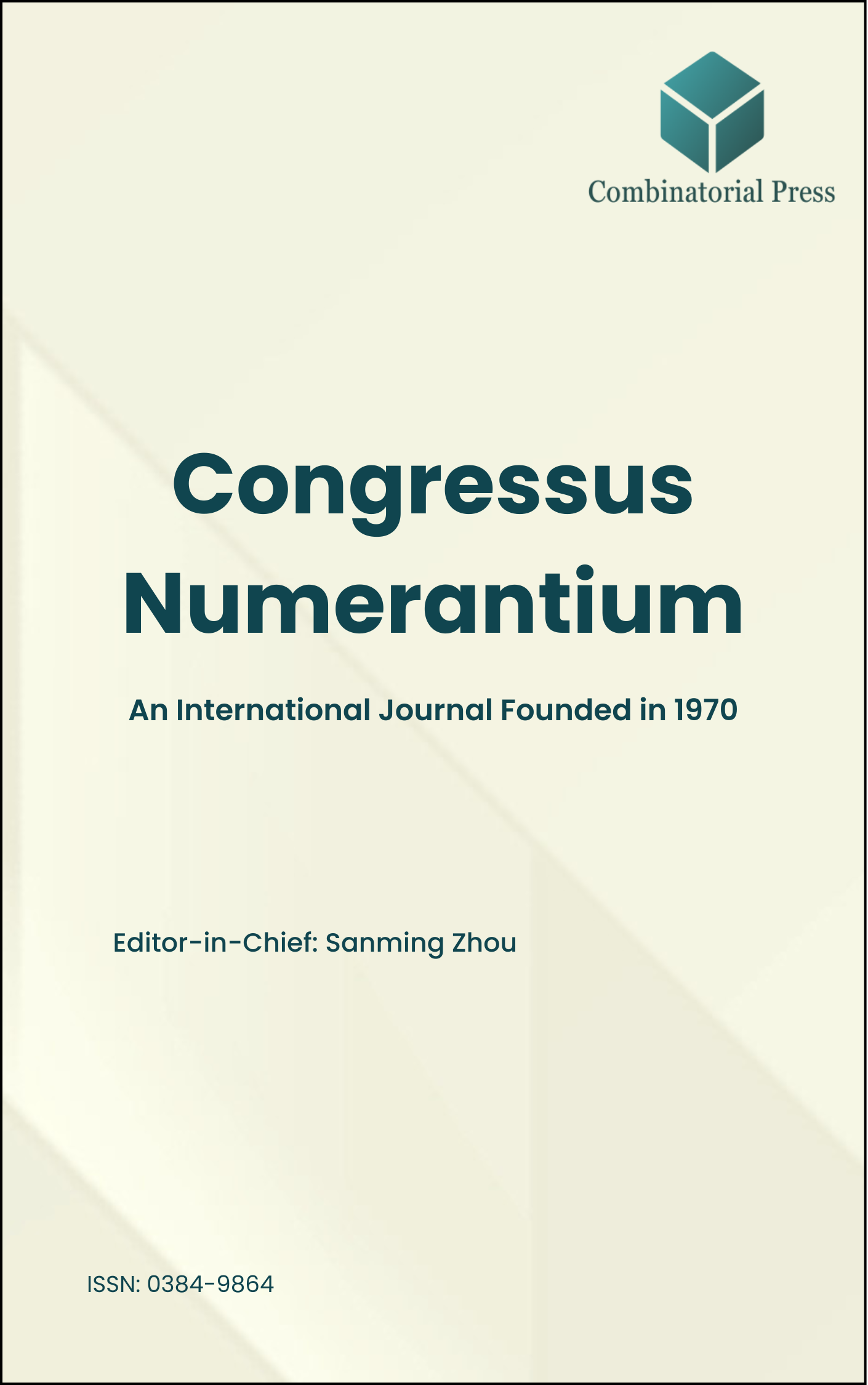
Congressus Numerantium
ISSN: 0384-9864
Established in 1970, Congressus Numerantium is one of the oldest international journals with a focus on publishing high-quality papers in combinatorics and related areas. Over the years, it has published numerous fully refereed regular papers and conference proceedings for many prestigious conferences. However, publication was temporarily paused on January 15, 2020. Throughout its active years, Congressus Numerantium adopted a print format, following a subscription-based model for readers and releasing 234 Volumes. Despite the changing landscape of academic publishing, Congressus Numerantium demonstrated resilience. In 2024, the journal embarked on a transformative journey, reemerging in both print and online formats with the objective of publishing 2 volumes annually, scheduled for release in June and December. We cordially invite original research papers and survey articles, welcoming significant contributions to both the pure and applied aspects of combinatorics. Furthermore, we extend a warm invitation for special issues dedicated to conferences and workshops in combinatorics and related fields, carrying forward the rich tradition of this esteemed journal. Special issues on selected topics of current interest to the community of combinatorics are also welcome.
- Research article
- https://doi.org/10.61091/cn235-05
- Full Text
- Congressus Numerantium
- Volume 235
- Pages: 47-64
- Published: 11/02/2025
A radio labeling of a graph
- Research article
- https://doi.org/10.61091/cn235-04
- Full Text
- Congressus Numerantium
- Volume 235
- Pages: 41-46
- Published: 11/02/2025
Let
- Research article
- https://doi.org/10.61091/cn235-03
- Full Text
- Congressus Numerantium
- Volume 235
- Pages: 23-40
- Published: 11/02/2025
An open-locating-dominating set of a graph models a detection system for a facility with a possible “intruder” or a multiprocessor network with a possible malfunctioning processor. A “sensor” or “detector” is assumed to be installed at a subset of vertices where each can detect an intruder or a malfunctioning processor in its neighborhood, but not at its own location. We consider a fault-tolerant variant of an open-locating-dominating set called an error-correcting open-locating-dominating set, which can correct a false-positive or a false-negative signal from a detector. In particular, we prove the problem of finding a minimum error-correcting open-locating-dominating set in an arbitrary graph is NP-complete. Additionally, we characterize the existence criteria for an error-correcting open-locating-dominating set in an arbitrary graph. We also consider extremal graphs that require every vertex to be a detector and minimum error-correcting open-locating-dominating sets in infinite grids.
- Research article
- https://doi.org/10.61091/cn235-02
- Full Text
- Congressus Numerantium
- Volume 235
- Pages: 5-21
- Published: 11/02/2025
Let
- Congressus Numerantium
- Volume 235
- Pages: 3-4
- Published: 11/02/2025
- Research article
- Full Text
- Congressus Numerantium
- Volume 234
- Pages: 261-272
- Published: 31/12/2019
A Magic Venn Diagram is a magic figure where regions of a Venn diagram are labeled such that the sums of the regional labels of each set are the same. We have developed a backtracking search to count the number of Magic Venn Diagrams. The algorithm could determine the number of Magic Venn Diagrams for all Venn diagrams with four sets. This paper presents the algorithm with its applied heuristics and lists the computational results.
- Research article
- Full Text
- Congressus Numerantium
- Volume 234
- Pages: 247-260
- Published: 31/12/2019
A famous open problem in the field of rendezvous search is to ascertain the rendezvous value of the symmetric rendezvous problem on the line, wherein both agents begin two units apart. We provide a new, Bayesian framework to both create new strategies for the agents to follow and to provide a new interpretation of previously posited strategies.
Additionally, we have developed a method that modifies any strategy, even those with potentially infinite expected meeting time, into a new strategy that is guaranteed to have a finite expected meeting time. This process, combined with using our Bayesian framework to create new strategies, yields an upper bound that is within one percent of the current best upper bound for the symmetric rendezvous value.
- Research article
- Full Text
- Congressus Numerantium
- Volume 234
- Pages: 225-246
- Published: 31/12/2019
The Astronaut Problem is an open problem in the field of rendezvous search. The premise is that two astronauts randomly land on a planet and want to find one another. Research explores what strategies accomplish this in the least expected time.
To investigate this problem, we create a discrete model which takes place on the edges of the Platonic solids. Some baseline assumptions of the model are:
- The agents can see all of the faces around them.
- The agents travel along the edges from vertex to vertex and cannot jump.
- The agents move at a rate of one edge length per unit time.
The 3-dimensional nature of our model makes it different from previous work. We explore multi-step strategies, which are strategies where both agents move randomly for one step, and then follow a pre-determined sequence.
For the cube and octahedron, we are able to prove optimality of the “Left Strategy,” in which the agents move in a random direction for the first step and then turn left. In an effort to find lower expected times, we explore mixed strategies. Mixed strategies incorporate an asymmetric case which, under certain conditions, can result in lower expected times.
Most of the calculations were done using first-step decompositions for Markov chains.
- Research article
- Full Text
- Congressus Numerantium
- Volume 234
- Pages: 213-224
- Published: 31/12/2019
Our research focuses on the winning probability of a novel problem posted on a question-and-answer website. There are
We are interested in which initial position has the greatest chance to survive, that is, the highest probability to be the last one remaining. Specifically, we have derived recursions to solve for exact values and the formula of the winning probabilities.
We have also considered variations of the problem, where people are grouped into triples, quadruples, etc., and the first person in each group is at the risk of being selected. We will also present various sequences we have discovered while solving for the winning probabilities of the different variations, as well as other possible extensions and related findings concerning this problem.
- Research article
- Full Text
- Congressus Numerantium
- Volume 234
- Pages: 195-212
- Published: 31/12/2019
Our research studies the expected survival time in a novel problem posted on a question-and-answer website. There are
We are interested in which initial position has the largest expected number of turns to stay in the line before being selected, which we refer to as “expected survival time.” In this paper, we use a recursive approach to solve for exact values of the expected survival time. We have proved the exact formula of the expected survival time of the first and the last position as well. We will also present our work on the expected survival time of the other positions,





